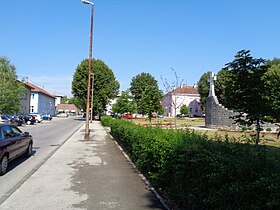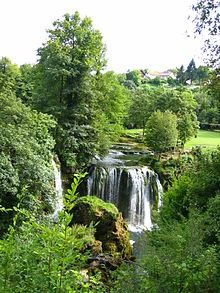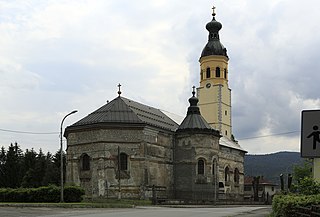
Karlovac County is a county in central Croatia, with the administrative center in Karlovac.
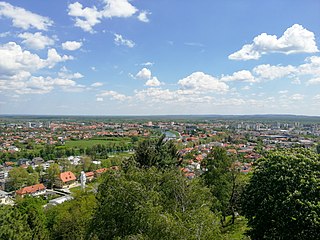
Karlovac is a city in central Croatia. According to the 2021 census, its population was 49.377.

Ogulin is a town in north-western Croatia, in Karlovac County. It has a population of 7,389 (2021), and a total municipal population of 12,251 (2021). Ogulin is known for its historic stone castle, known as Kula, and the nearby mountain of Klek.
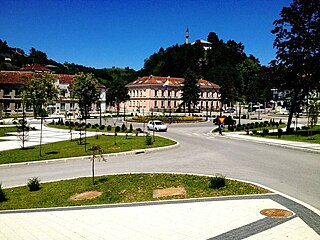
Cazin is a city located in Una-Sana Canton of the Federation of Bosnia and Herzegovina, an entity of Bosnia and Herzegovina. It is situated in northwest Bosnia and Herzegovina in the Bosanska Krajina region, near the border with Croatia. As of 2013, it has a population of 66,149 inhabitants.

Cetingrad is a municipality in Karlovac County, Croatia near Croatia's border with Bosnia. The population of the village itself is 319, while the total municipality population is 2,027 (2011). The municipality is part of Kordun. Cetingrad is underdeveloped municipality which is statistically classified as the First Category Area of Special State Concern by the Government of Croatia.

The Korana is a river in central Croatia and west Bosnia and Herzegovina. The river has a total length of 138.6 km (86.1 mi) and watershed area of 2,301.5 km2 (888.6 sq mi).

Delnice is a town in western Croatia, the largest settlement in the mountainous region of Gorski Kotar, in the Primorje-Gorski Kotar County. The town has a population of 4,379, and total municipality population is 5,952 (2011). Delnice is Gorski Kotar's main town.
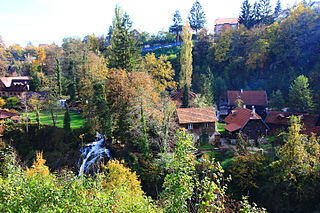
Rastoke is a village, located in the Town of Slunj, known for the Slunjčica River, which flows into the Korana River at Rastoke.
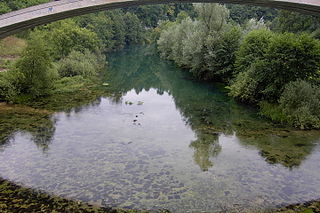
The Slunjčica is a river, which flows through the Kordun region in central Croatia. It partly flows underground through porous karst and surfaces in the vicinity of the city of Slunj. At Rastoke the Slunjčica leads into the river Korana, which reaches this point after passing the Plitvice Lakes National Park. The city of Slunj bears its name from this river. Due to its underground course the Slunjčica river has a quite cold temperature even during summer and the nearby situated towns use it as drinking water.

Josipdol is a village and municipality in Karlovac County, Croatia. It is part of Lika region.

Glina is a town in central Croatia, located southwest of Petrinja and Sisak in the Sisak-Moslavina County. It lies on the eponymous river Glina.

Krnjak is a village and a municipality in Karlovac County, Croatia.
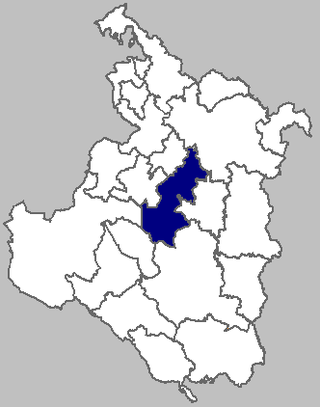
Barilović is a village and a municipality in central Croatia, in the Karlovac County.
The Cazin rebellion was an armed anti-state rebellion of peasants that occurred in May 1950 in the towns of Cazin and Velika Kladuša in the Bosanska Krajina region, as well as Slunj in Croatia, at that time part of Communist Yugoslavia. The peasants revolted against the forced collectivization and collective farms set up by the Yugoslav government following a drought in 1949, after which they had been punished due to their inability to meet the quotas. The ringleaders were persecuted and some killed, including many innocent civilians.
Donji Cerovac is a village in Croatia, under the Slunj township, in Karlovac County.
Donji Lađevac is a village in Croatia, under the Slunj township, in Karlovac County.
Donji Popovac is a village in Croatia, under the Slunj township, in Karlovac County.
Gornji Cerovac is a village in Croatia, under the Slunj township, in Karlovac County.


